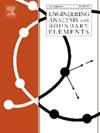Properties optimisation of nanostructures via machine learning: Progress and perspective
IF 4.2
2区 工程技术
Q1 ENGINEERING, MULTIDISCIPLINARY
Engineering Analysis with Boundary Elements
Pub Date : 2025-02-01
DOI:10.1016/j.enganabound.2024.106063
引用次数: 0
Abstract
Nanostructures play a vast role in the current Internet of NanoThings (IoNT) era due to remarkable properties and features that precisely impart their desired application functions in catalysis, energy and other fields. The exploration in understanding their minute features caused by the flexibility of compositional and complex atomic arrangement from the synthesis reaction widely opens for the in-depth discovery of their search space such as particle size, morphology and structures that controlled the characteristics. A wide range of possible compositions and various lattice atomic arrangements combined with small particle size distribution and large surface area create grand challenges to copy/differentiate their corresponding specific properties. Thus, the employment of machine learning (ML)-based strategies using the closed-loop experimental data from the nanostructure synthesis to help navigate and optimise for the large classes of data attributes related to the size, morphology and other properties from the trained model are reviewed. The data attributes are assisted by discussions of the selected case studies from the recent literature that highlight different condition nanostructures. The review concludes with a discussion of perspectives on the major challenges in the implementation of ML data-driven design in the field of nanostructure synthesis.
基于机器学习的纳米结构性能优化:进展与展望
纳米结构在当前的纳米物联网(IoNT)时代发挥着巨大的作用,由于其显著的性质和特征,精确地赋予其在催化,能源和其他领域所需的应用功能。从合成反应中对其组成的灵活性和复杂的原子排列所引起的微小特征的探索,为深入发现其粒径、形态和结构等控制特征的搜索空间打开了广阔的大门。广泛的可能组成和各种晶格原子排列,结合小颗粒尺寸分布和大表面积,给复制/区分其相应的特定性质带来了巨大的挑战。因此,本文回顾了使用来自纳米结构合成的闭环实验数据的基于机器学习(ML)的策略,以帮助导航和优化与训练模型的大小、形态和其他属性相关的大类数据属性。数据属性是由最近的文献,突出不同条件的纳米结构选定的案例研究的讨论协助。本文最后讨论了在纳米结构合成领域实现机器学习数据驱动设计的主要挑战。
本文章由计算机程序翻译,如有差异,请以英文原文为准。
求助全文
约1分钟内获得全文
求助全文
来源期刊

Engineering Analysis with Boundary Elements
工程技术-工程:综合
CiteScore
5.50
自引率
18.20%
发文量
368
审稿时长
56 days
期刊介绍:
This journal is specifically dedicated to the dissemination of the latest developments of new engineering analysis techniques using boundary elements and other mesh reduction methods.
Boundary element (BEM) and mesh reduction methods (MRM) are very active areas of research with the techniques being applied to solve increasingly complex problems. The journal stresses the importance of these applications as well as their computational aspects, reliability and robustness.
The main criteria for publication will be the originality of the work being reported, its potential usefulness and applications of the methods to new fields.
In addition to regular issues, the journal publishes a series of special issues dealing with specific areas of current research.
The journal has, for many years, provided a channel of communication between academics and industrial researchers working in mesh reduction methods
Fields Covered:
• Boundary Element Methods (BEM)
• Mesh Reduction Methods (MRM)
• Meshless Methods
• Integral Equations
• Applications of BEM/MRM in Engineering
• Numerical Methods related to BEM/MRM
• Computational Techniques
• Combination of Different Methods
• Advanced Formulations.
 求助内容:
求助内容: 应助结果提醒方式:
应助结果提醒方式:


